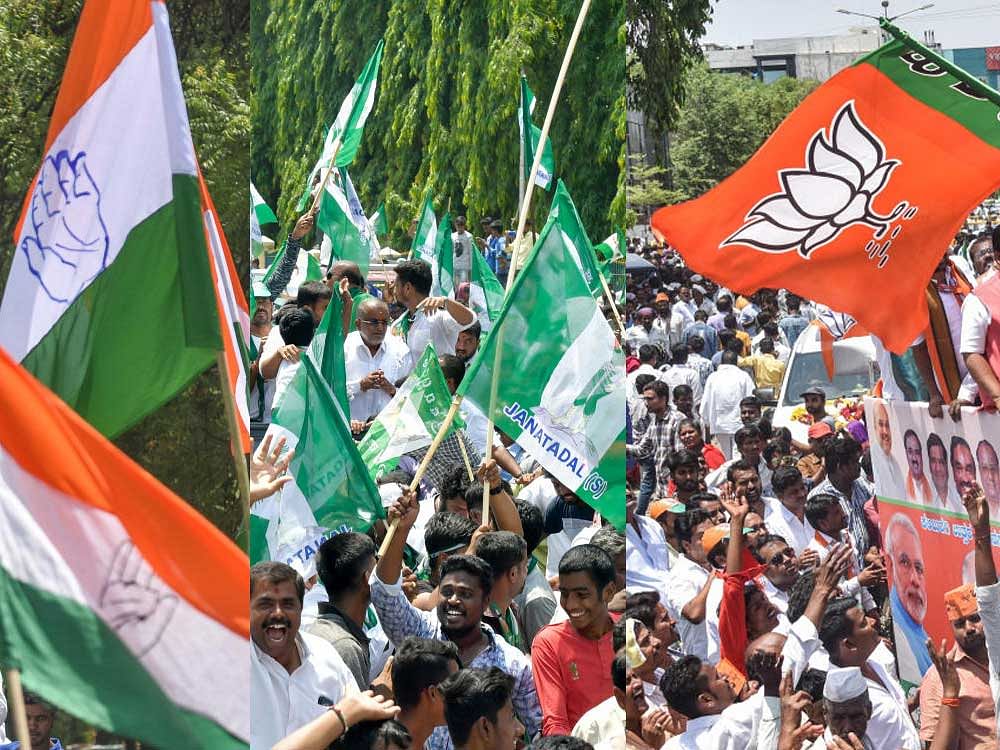Much has been spoken about the x-factors and the third party presence in the run-up to the Karnataka elections. With the BJP raising the level of its attacks and its aggressive tactics to target every act of criminality in the state to the failing law and order, there is a feeling among the general public that the party in power may be at a loss to defend itself.
This coupled with the JD(S)-BSP alliance, it is an interesting time to watch. Above all, the pundits are watching out for Prime Minister Narendra Modi’s visit to see its effects on the outcome of the elections through the crystal gaze.
It is true that most of the unfortunate incidents like the murder of writer-activist Kalburgi, journalist Gowri Lankesh, deaths of BJP/RSS/VHP activists as claimed by their leaders, the retaliatory murders of Muslim youths in Mangaluru, Mohammed Nalapad Haris’s brutal attack on a youth, stabbing of Lokayukta in his office and the everyday violence in the coastal region have come at a very crucial time, shaking up the confidence of the ruling party.
The Congress has defended itself bravely, exemplifying its impartial investigations as its strength. But the party needs to learn from its past experiences. In these critical times, the Congress leadership has exemplified its failures in letting go the Meghalaya victory to the BJP in a similar fashion that resembles Goa and Manipur, lowering the morale of the Congress workers. Once the masters of the game of stealing democratically elected governments, the Congress today under its weak and hesitant leadership seems to be giving in to the designs of the BJP’s “Congress Mukth Bharat” dream. The fear is, will Karnataka be the next victim if the JD(S) plays its fiddle in favour of the BJP if the three opinion polls are to be believed.
Ticket distribution is a crucial factor in elections. The dissension within parties comes to the fore as the process unravels. The ugly scenes of breaking office furniture and destroying public property for individual gains presents an opportunistic behaviour of the so-called party loyalists. The sojourn of BJPs leadership through the Lingayat mutts and their cautious steps in ticket distribution indicates the fragility with which they have to keep their voters’ bastion intact for keeping silent on the issue of minority status to the Lingayats. Yet, if one goes by the relation between their vote share and seats won by the BJP, they have nothing to fear as the figures indicate that they have a much more consistent pattern compared to the Congress.
Despite this truth, the fact that there is a caste equation that is alive needs a gaze. In the last election, it is true that the Lingayats voted for the BJP while the Vokkaligas were divided between the Congress and the JD(S). Will this trend continue or go the other way, will the mutts lobby in favour of a party? In the given context of the Veershaiva/Lingayat breakup for the minority status, there seems to be no clear view regarding the party loyalties.
It is likely that this bunch of votes will be the most divided in their choice of voting. Their loyalties would be shared between the BJP, JD(S) and the Congress. The Vokkaligas on the other hand, over the fact that the JD(S) struck an alliance with the BSP, is likely to vote for the Congress in a bigger way.
The Congress is expected to get a major vote share not only from these two communities but from the minorities and the OBCs too. However, the problem for the Congress is the inconsistency of its percentage of vote share and the seats it has won. Thus the party will be safe in a constituency where there is a three-way contest than in a two-way contest.
Hoping for magic
With the upheavals over ticket distribution and the shifting of loyalties to catch the winning horse, both the parties and the individuals are fishing in troubled waters. The consolidation of Hindu votes and the BJP’s claims on majority Hindus is being challenged by those who called themselves secular, waiting to politicise swamijis and mutts. While Modi’s visit is raising the heat, Chief Minister Siddaramaiah’s choice for the second constituency against the wishes of his high command is seen as nervousness among the Congress.
In this confusion, pundits are divided about the result giving added advantage to the JD(S) as the likely kingmaker. But the truth lies at the ground level with each party trying its best to compete with the other for a better result in their favour. Modi’s arrival this week will perhaps set the pace of this election with newer issues to grapple with – his attack against the government in matters of law and order and the chief minister is certain. His handling of the Lingayat/Veerashiva issue will settle the voters’ choice of party in north Karnataka. Certainly, the BJP is hoping for a magic in Modi’s visit.
Despite this, who knows how people vote and what is in their heart? In an age of personalisation of politics, parliamentary systems are becoming more leader-centric. Fundamental changes, like voters drifting away from their traditional party loyalties, the decline in mass memberships of parties, the growth of 24X7 visual media and disruptive technologies like social media, have weakened predictability among the political scientists.
The image of a candidate/party and how it is perceived by the voter is central to a party’s victory. With companies like Cambridge Analytica at the centre of campaigns hiring independent professionals mastering the art of data breach and supported by fake news and videos to swing election campaigns, results could be anybody’s guess at this stage. The voter in this spree for winning an election in a democracy is a casualty and can hope to accomplish nothing unless they come together as a community.
--
(The writer, a political analyst, teaches political science at Karnatak University, Dharwad)
